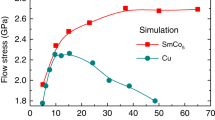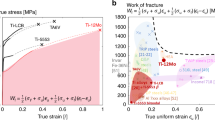Abstract
Dislocation-based deformation in crystalline solids is almost always plastic. Here we show that polycrystalline samples of Ti3SiC2 loaded cyclically at room temperature, in compression, to stresses up to 1 GPa, fully recover on the removal of the load, while dissipating about 25% (0.7 MJ m−3) of the mechanical energy. The stress–strain curves outline fully reversible, rate-independent, closed hysteresis loops that are strongly influenced by grain size, with the energy dissipated being significantly larger in the coarse-grained material. At temperatures greater than 1,000 °C, the loops are open, the response is strain-rate dependent, and cyclic hardening is observed. This hitherto unreported phenomenon is attributed to the reversible formation and annihilation of incipient kink bands at room-temperature deformation. At higher temperatures, the incipient kink bands dissociate and coalesce to form regular irreversible kink bands. The loss factor for Ti3SiC2 is higher than most woods, and comparable to polypropylene and nylon. The technological implications of having a stiff, lightweight machinable ceramic that can dissipate up to 25% of the mechanical energy per cycle are discussed.
This is a preview of subscription content, access via your institution
Access options
Subscribe to this journal
Receive 12 print issues and online access
$259.00 per year
only $21.58 per issue
Buy this article
- Purchase on Springer Link
- Instant access to full article PDF
Prices may be subject to local taxes which are calculated during checkout




Similar content being viewed by others
References
Barsoum, M.W. The MN+1AXN phases: A new class of solids: thermodynamically stable nanolaminates. Prog. Solid State Chem. 28, 201–281 (2000).
Nowotny, H. Struktuchemie Einiger Verbindungen der Ubergangsmetalle mit den elementen C, Si, Ge, Sn. Prog. Solid State Chem. 2, 27 (1970).
Pietzka, M.A. & Schuster, J.C. Summary of constitution data of the system Al-C-Ti. J. Phase Equilib. 15, 392–400 (1994).
Rawn, C.J. et al. Structure of Ti4AlN3−x- a layered Mn+1AXn nitride. Mater. Res. Bull. 35, 1785–1796 (2000).
Barsoum, M.W. & El-Raghy, T. Synthesis and characterization of a remarkable ceramic: Ti3SiC2 . J. Am. Ceram. Soc. 79, 1953–1956 (1996).
Pampuch, R., Lis, J., Stobierski, L. & Tymkiewicz, M. Solid combustion synthesis of Ti3SiC2 . J. Eur. Ceram. Soc. 5, 283–287 (1989).
Finkel, P., Barsoum, M.W. & El-Raghy, T. Low temperature dependencies of the elastic properties of Ti3Al1.1C1.8, Ti4AlN3 & Ti3SiC2 . J. Appl. Phys. 87, 1701–1703 (2000).
Gilbert C.J. et al. Fatigue-crack growth and fracture properties of coarse and fine-grained Ti3SiC2 . Scripta Mater. 42, 761–767 (2000).
Radovic, M., Barsoum, M.W., El-Raghy, T. & Wiederhorn, S. Tensile creep of fine-grained (3–5 μm) Ti3SiC2 in the 1000–1200 °C temperature range. Acta Mater. 49, 4103–4112 (2001).
Radovic, M., Barsoum, M.W., El-Raghy, T., Wiederhorn, S. & Luecke, W. Effect of temperature, strain rate and grain size on the mechanical response of Ti3SiC2 in tension. Acta Mater. 50 1297–1306 (2002).
Farber, L., Levin, I. & Barsoum, M.W. HRTEM study of a low-angle boundary in plastically deformed Ti3SiC2 . Phil. Mag. Lett. 79, 163–170 (1999).
Barsoum, M.W., Farber, L. & El-Raghy, T. Dislocations, kink banks and room temperature plasticity of Ti3SiC2 . Metall. Mater. Trans. A 30, 1727–1738 (1999).
Barsoum, M.W. & El-Raghy, T. Room temperature ductile carbides. Metall. Mater. Trans. A 30, 363–369 (1999).
El-Raghy, T. & Barsoum, M.W. Processing and mechanical properties of Ti3SiC2: Part I: Reaction path and microstructure evolution. J. Am. Ceram. Soc. 82, 2849–54 (1999).
El-Raghy, T., Barsoum, M.W., Zavaliangos, A. & Kalidindi, S.R. Processing and mechanical properties of Ti3SiC2: II, Effect of grain size and deformation temperature. J. Am. Ceram. Soc. 82, 2855–2860 (1999).
Li, J–F., Pan, W., Sato, F. & Watanabe, R. Mechanical properties of polycrystalline Ti3SiC2 at ambient and elevated temperatures. Acta. Mater. 49, 937–945 (2001).
Orowan, E. A type of plastic deformation new in metals. Nature 149, 463–464 (1942).
Hess, J.B. & Barrett, C.S. Structure and nature of kink bands in zinc. Trans. Am. Inst. Min. Eng. 185, 599–606 (1949).
Frank, F.C. & Stroh, A.N. On the theory of kinking. Proc. Phys. Soc. 65, 811–821 (1952).
Nowick, A.S. & Berry, B.S. Anelastic Relaxation in Crystalline Solids (Academic, New York, 1972).
Schaller, R., Fantozzi, G. & Gremaud, G. (eds) Mechanical Spectroscopy 2001 (Trans. Tech., Zürich, Switzerland, 2001).
Roberts, J.M. & Brown, N. Low frequency friction in zinc single crystals. Acta. Metall. 10, 430–441 (1962).
Washburn, J. & Roper, E.R. Kinking in Zn single crystal tension specimens. J. Metals 1076–1078 (1952).
El-Danaf, E., Kalidindi, S.R. & Doherty, R.D. Influence of grain size and stacking fault energy and on deformation twinning in FCC metals. Metall. Mater. Trans. A 30, 1223–1233 (1999).
Inokuti Y. & Cantor, B. Acta Metall. 30, 343–356 (1982).
Acknowledgements
The authors would like to thank Y. Gogotsi of Drexel University for his critical reading of the paper. This work was funded by the Army Research Office (DAAD19-00-1-0435) and the Division of Materials Research of the National Science Foundation (DMR-0072067).
Author information
Authors and Affiliations
Corresponding author
Ethics declarations
Competing interests
The authors declare no competing financial interests.
Rights and permissions
About this article
Cite this article
Barsoum, M., Zhen, T., Kalidindi, S. et al. Fully reversible, dislocation-based compressive deformation of Ti3SiC2 to 1 GPa. Nature Mater 2, 107–111 (2003). https://doi.org/10.1038/nmat814
Received:
Accepted:
Published:
Issue Date:
DOI: https://doi.org/10.1038/nmat814
This article is cited by
-
Mechanical properties of SPS-processed Cr2AlC MAX phase with different impurity contents
Emergent Materials (2023)
-
Rational Synthesis of Mixed Metal Oxide Clusters Supported on a Partially Etched MAX Phase for Efficient Electrocatalytic CO2 Conversion
Topics in Catalysis (2022)
-
Laser Additive Manufacturing on Metal Matrix Composites: A Review
Chinese Journal of Mechanical Engineering (2021)
-
The rise of plastic deformation in boron nitride ceramics
Science China Materials (2021)
-
Thermo-Mechanical Simulation of Self-Heating of a High-Power Diode Made of Ti3SiC2 (MAX) Phase-on-4H-SiC Substrate
Journal of Thermal Science (2021)



